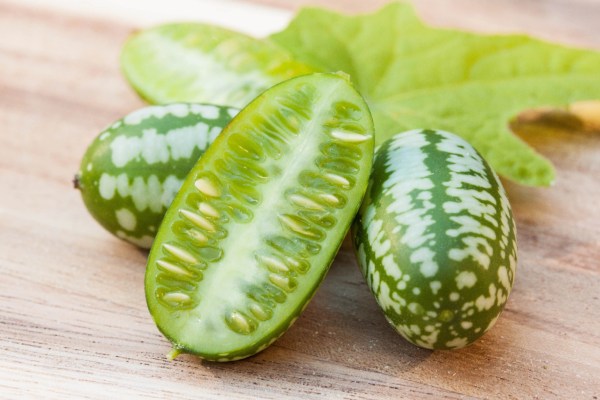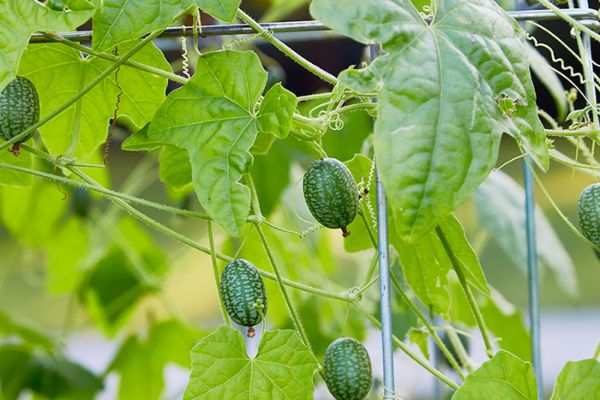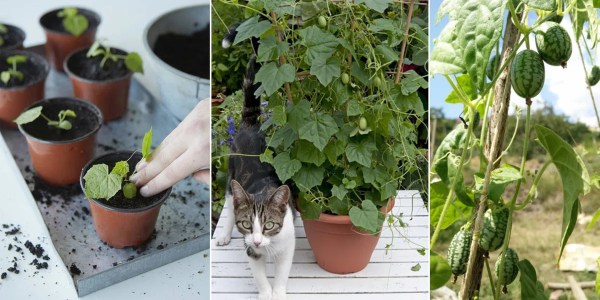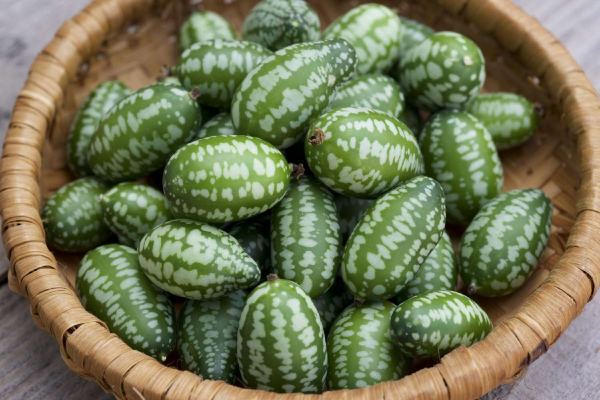Cucamelon is a fascinating fruit that looks like a miniature watermelon, tastes like a cucumber with a light, tangy flavor similar to citrus fruits, and is about the size of a grape. It is also recognized by other names like Mexican sour gherkins, Mouse melons, Melothria scabra, and more. Cucamelon is native to Mexico and Central America. They are perfect for small gardens because each plant produces an abundance of these tiny, juicy fruits. Additionally, it provides health benefits because it is rich in vitamins and antioxidants.
Plant Descriptions
Plant Type: Fruit, Perennial, Annuals, Vine, Tubers
Scientific Name: Melothria scabra
Other Name: Cucamelon, Mexican sour gherkin, Mexican gherkin, Mexican miniature watermelon, Mouse melon, Pepquinos, sandiita
Family: Cucurbitaceae
Season: Spring, Summer
Native Area: Central America, Mexico
Toxicity: Non-toxic
What is special about Cucamelons?
Cucamelons have been grown in countries such as Mexico and Venezuela for centuries. In recent years, they have gained popularity in the United States as well. You can enjoy cucamelons as salads, use them as a garnish, or add them to refreshing cocktails. You may be creative with them by simply pickling them for a sour taste. Picked cucamelons are great on charcuterie boards and sandwiched. In short, you can use them just like cucumbers.

How to Grow Cucamelons in a Container?
Cucamelons can thrive in all types of containers, including grow bags. To grow cucamelon in a container, ensure pots are at least 30 cm wide and deep to accommodate the vigorous plant. Since this plant forms long vines, it is best to provide strong support, such as a trellis, wigwam system, or a short length of bamboo next to each plant to help it climb.
First, fill up the container with well-draining soil. You can also mix in compost or aged manure to improve drainage and enhance the amount of nutrients. However, the soil should constantly be moist but not waterlogged. Additionally, Cucamelon requires full sun. Place them beside a sunny window or use grow lights if the natural light is poor.
Caring Tips for Cucamelons
Sunlight
Pick a sunny location for growing cucamelons, as they thrive in full sun. It needs at least 6 to 8 hours of bright sunlight each day. In hot climates, they can handle some partial shade.
Soil Preparation
This miniature watermelon prefers moist, well-drained, fertile soil. The ideal PH for growing Cucamelons is between 6.0 and 7.0. Before planting, enrich the soil by adding some compost and a layer of mulch.
Watering
Keep the soil consistently moist while growing cucamelons, but be sure not to make it waterlogged. Plants in hot climates or containers may require more frequent watering.
Temperature and Humidity
Cucamelons thrive best in warm weather between 70 and 85°F. At the same time, these plants are sensitive to frost and cold temperatures. They generally manage moderate humidity, but high humidity with poor airflow can cause powdery mildew.

Fertilizer
Cucamelons require a high-potassium liquid fertilizer once or twice during the season. Apply the first dose when seedlings start appearing and apply the second in mid-summer. Similarly, use a balanced, organic fertilizer every few weeks until the plants flower, then switch to high-potassium fertilizer to boost fruit production.
Pruning
Cucamelon is a vine that needs a trellis to climb as it grows. If you don’t train it to claim properly or prune it, it can spread too much. To keep it healthy, prune it in the spring and summer. When the vines get to about 8 feet tall, trim the tips. This helps the plant grow more, branch out, and produce more fruits.
Pest and Diseases
Cucamelon plants are pretty hardy and resistant to pests and diseases. They sometimes may be affected by powdery mildew or aphids. To prevent these issues, water the soil directly to keep the foliage dry, and ensure good air circulation around the plant.
Propagating Cucamelons from seeds
Propagation of Cucamelons from seeds is easiest, especially when you save seeds from the previous fruit-bearing season. Here is a step-by-step guide to growing new, healthy cucamelon plants:
1. Preparing seeds: Cut the cucamelon in half, remove the seeds, and wash them. Soak the seeds in water for some days, then throw away the floating seeds, and let the rest good the seeds dry on a paper towel.
2. Storage and Timing: Store the seeds in a cool, dry place until about a month before the last frost. Indoor sowing begins as early as April to sow directly in greenhouses or mid-April to early May for outdoor growing.
3. Sowing: Fill the seedling tray with rich soil and plant the seeds 1/4 to 1/2 inch deep. Keep the soil moist but not soggy, and then place it in a sunny area with temperatures above 70°F.

4. Transplanting: Fill 9cm pots with peat-free compost and transplant seedlings once they reach 6 cm tall. Ensure that the plants get a trellis to support them and plenty of light for ideal growth.
5. Final planting: Let them grow in for a few weeks until they are ready to plant outside after the last frost. After that, you may move the plants to their final location, near a trellis, in full sun with well-draining soil.
Also read, What is Borax? Know its amazing benefits to use around your houses
Frequently Asked Questions
1. What are Cucamelon?
Cucamelon is a fascinating fruit that looks like a miniature watermelon, tastes like a cucumber, and is about the size of a grape.
2. What does Cucamelon taste like?
Cucamelon tastes like a cucumber with a light, tangy flavor similar to citrus fruits.
3. How do I grow Cucamelons in a container?
To grow Cucamelons in a container, select a pot that is about 30 cm wide and deep. Add a trellis or bamboo for support. Fill it with a good draining potting mix and compost. Keep the soil moist but not waterlogged, and place it under direct sunlight or grow lights.
4. How should I care for Cucamelons throughout the growing season?
Cucamelons need regular watering, a high-potassium fertilizer once or twice a season, and some pruning. Trim the vines when they reach about 8 feet in spring and summer to help them grow more branches and fruits. Keep an eye out for pests like aphids and diseases like powdery mildew.
5. How can I propagate Cucamelons from seeds?
To grow cucamelons from seeds, cut the fruits, rinse, and soak the seeds. Store them in a cool, dry place. After this, a month before the last frost, plant them about 1/4 to 1/2 inch deep in good rich soil. When seedlings grow to about 6 cm, transplant them into larger pots, keeping them near a trellis in full sun.
